Beech Nuts A to Z: Gathering Tips & Gourmet Uses
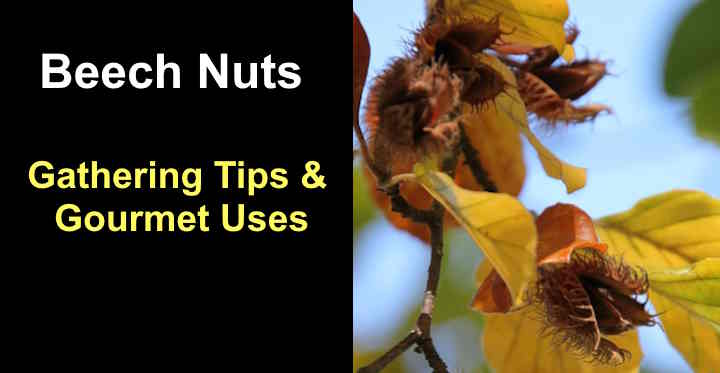
Beech nuts are delicious and versatile nuts found on the forest floors of deciduous forests. They are easy to recognize by their distinctive spiky husks covering two small nuts. Beech nuts are usually ready for gathering in late fall. Although you can eat them raw, they are much tastier when cooked or roasted.
Gathering your own food is a great way to dip into nature’s pantry. If you know what you’re looking for, a woodland floor is full of edible produce—from tasty mushrooms to soft fruits, edible wild plants, and delicious nuts. Of course, foraging for forest food requires knowledge of what is edible and what is not.
This article is a guide to harvesting and preparing beech nuts as food. You’ll also get ideas for incorporating them into tasty treats and snacks.
What Are Beech Nuts?

The image above/left shows the beechnut, the fruit of the beech tree, alongside its spiky husks known as cupules
Beech nuts—also called beechnuts or beech mast—are the edible fruit of beech trees (Fagus spp.). They are small nuts with a triangular shape and are found in spiny (prickly) husks. The little brown nuts measure 0.6” (1.5 cm) and are ready to harvest from trees in September.
Beech nuts are rich in healthy fats and proteins, making them a good food source for humans and wildlife. The nuts taste bitter or astringent due to their high tannin content. However, after roasting them, they develop a sweeter, nuttier taste as the cooking process destroys the tannins.
Beech nuts have an excellent nutritional profile. They contain 20 percent protein, significantly more than many other tree nuts, like acorns. Also, they contain 50 percent fat, along with minerals, amino acids, and vitamins. Even though they have a bitter taste due to tannins, they are not as astringent as other tree nuts.
Common beech trees in North America producing beech nuts include the American beech (Fagus grandifolia) and the European beech (Fagus sylvatica).
Identification of Beech Trees and Nuts
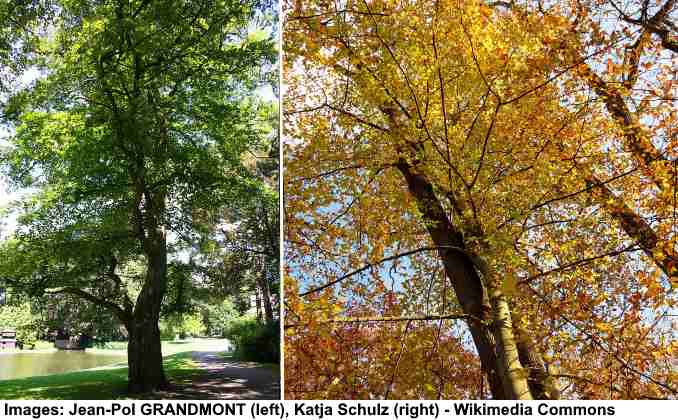
American Beech Trees (Fagus grandifolia)
Beech trees are high-branching, tall, deciduous trees with stout trunks and smooth, silvery-gray bark. The native American beech tree (Fagus grandifolia) grows tall at 52 to 115 ft. (16 – 35 m). It’s identified by its dark green, ovate leaves with serrated margins measuring 2.3” to 5” (6 – 13 cm) long.
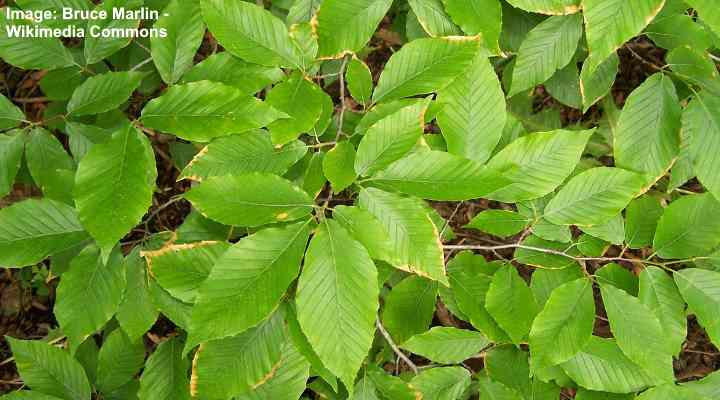
American beech leaves
Beech tree leaves are distinctive due to the pairs of straight veins coming off the central vein. These end in small tooth-like serrations on the beech leaf margins.
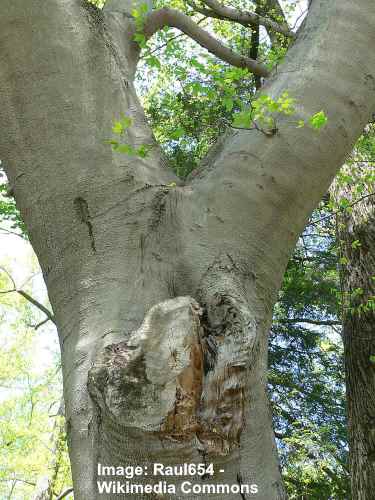
American beech bark
Beech trees are easy to recognize due to their grayish, smooth bark. However, some trees show signs of scales or fissures due to beech scale disease. This fungal infection also causes trees to produce seed husks without any nuts.
A feature of beech tree leaves is that they often stay on the tree throughout winter. This makes identification of beech trees easy when other species of trees have shed their leaves.
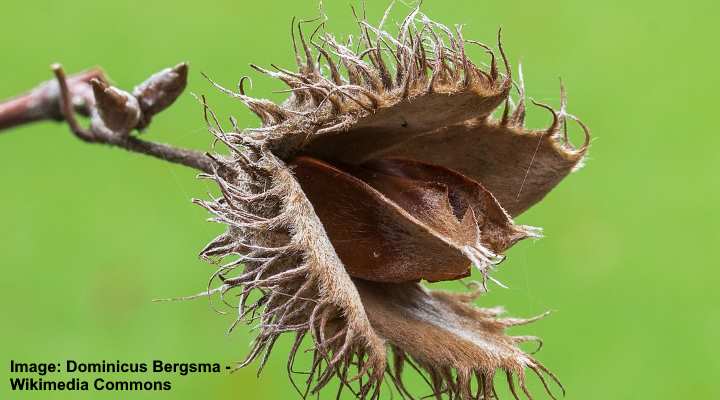
American beech fruit with nuts
Beechnuts are easy to tell apart from other tree nuts. The spiky, three-sided brown husks have three sides and a triangular form. The seed cases consist of four pointed lobes that open when the nuts are ready for harvesting. Typically, the prickly pods contain one or two nuts or beechmast.
Foraging for Beech Nuts
The best time to gather beech nuts is in the fall, from September through October. During this season, beech nuts are fully ripe and have fallen from the trees, making them easy to find. Foraging for beech nuts is simple but requires a keen eye and patience.
You can start foraging for the spiky husks among the golden brown leaves. Look for the distinctive three-sided nut shells that indicate ripe beech nuts.
Another harvesting method is by shaking the branches. However, you must ensure that you avoid damaging the trees or disturbing wildlife.
Once you identify ripe beech nuts, it’s vital to collect them carefully. It is essential to handle them gently, as they are delicate and can easily be damaged. You should avoid collecting empty husks or ones contaminated by animals or near sources of pollution.
You can consume raw beechnuts as you collect them. However, due to the mild toxin saponin glycoside, consuming too many raw nuts is not advisable. You may end up with stomach cramps or indigestion. However, cooking or roasting the nuts removes toxins and lowers the tannin content.
Preparing Beech Nuts for Consumption
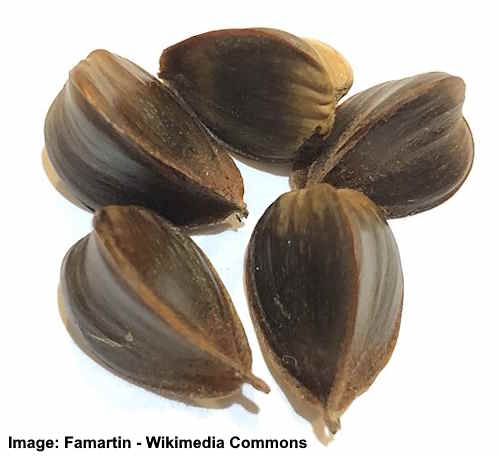
American beech nuts
Processing the beech nut pods is simple. You can grab a few spiny nut pods and husk them by rubbing them between towels. After that, carefully pick out the husks to leave the nuts in their brown shells. Although the husks look spiky, they are not sharp like chestnut husks. The soft spines are more like Velcro than jagged spikes.
After removing the husks, you can leave the nuts to dry for two to three weeks. Spread a single layer of the nuts and place them in a cool, well-ventilated indoor space. Curing the nuts this way improves their flavor. You can then store the nuts in a glass jar with a tight-fitting lid.
Before using beech nuts, you will need to remove the inner leathery shell. This is one of the most time-consuming aspects of harvesting large quantities of beech nuts. In most cases, it’s like shelling sunflower seeds.
The last step is gently roasting the nuts in a hot pan for three to five minutes until you sense their nutty aroma. Cooking them by frying or roasting destroys toxins and improves their flavor profile.
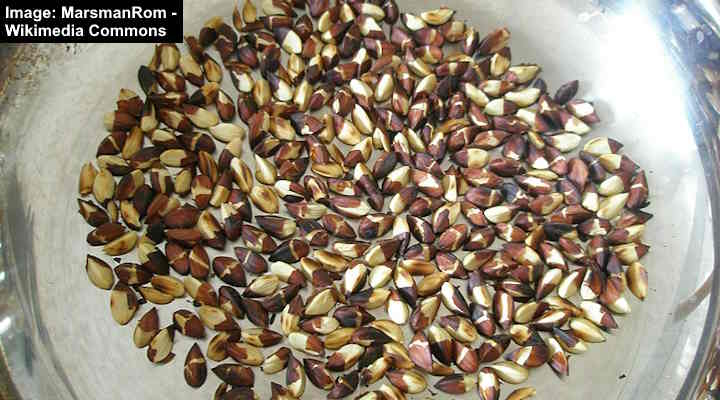
Roasted beech nuts in a pan
Culinary Uses of Beech Nuts
Beech nuts are delicious snacks on their own. But you can also incorporate them into various snacks and nut spreads.
Here are a few ideas on how to use foraged beechnuts:
Beech nut butter
Tasty beech nut butter is one of the best ways to enjoy the fruits of beech trees. To make the nut spread, you’ll need the following ingredients:
- Two cups of beechnuts shelled and roasted
- Two tablespoons of sunflower oil
- A pinch of salt
- One tablespoon of maple syrup or honey
Here is the recipe for beech nut butter:
- Preheat the oven to 350°F (175°C). Roast the beech nuts on a baking sheet for ten minutes or until the shells crack.
- Allow the nuts to cool. Remove the shells by rolling them between your fingers or using a nutcracker.
- Place the shelled nuts in a food processor or blender. Add sea salt and maple syrup or honey if desired.
- Whizz the nuts in the food processor for two to three minutes, scraping down the sides occasionally until the mixture turns into smooth butter.
- With the processor running, drizzle in the oil gradually to achieve a creamy consistency.
- Taste and adjust salt or sweetness as needed.
- Transfer the beech nut butter to a jar and store it in the refrigerator.
Enjoy beechnut butter on toast, crackers, or in recipes as a unique and flavorful alternative to traditional nut butters.
Beech nut muffins
You can make beech nut flour by blitzing roasted nuts in a blender for ten seconds until they become a fine powder. This allows you to add a nutty taste and texture to many baked goods. Avoid processing the nuts for too long, or they will form a paste.
Here is a quick recipe to make beech nut muffins. For this, you need the following ingredients:
Dry ingredients:
- One cup of beechnut flour
- One cup of standard white flour
- One cup cornmeal
- Three teaspoons of baking powder
- Some salt
- Half a cup of chopped beech nuts
Wet ingredients:
- Two beaten free-range eggs
- One and a half cups of milk
Recipe:
- Mix the dry ingredients in a large bowl apart from the chopped beechnuts
- Incorporate the milk and eggs
- Add the chopped beech nuts
- Put some of the mixture into greased muffin tins
- Bake at 375°F (190°C) for 20 minutes
- Allow to cool before consuming
You can also substitute beech nut flour for other types of regular or nut flours.
Beech nut coffee substitute
Roasting beech nuts allows you to make a tasty caffeine-free coffee substitute. All you need to do is roast beech nuts at 350°F (175°C) for about 15 to 20 minutes or until the shells crack. After they have cooled, peel the shells. Then, grind them in a coffee grinder and brew them in a French press like coffee.
Non-Culinary Uses of Beech Nuts
Harvested beech nuts are tasty, but there are several other ways to use them. Here are a few ideas.
Crafts
After removing beech nuts from their spiny husks, you can dry the smooth brown nuts to use them for making decorative items. You could string the polished nuts together to create necklaces or bracelets. Some people use the brown husks to create eco-friendly holiday wreaths.
Beech nut oil extraction
You will need an oil press to extract oil from beechnuts. Around 2.2 lbs. (1 kg) of nuts is required to make 11 fl. oz. (0.33 l) of cold-pressed beechnut oil. Some claim that beechnut oil helps improve skin health, relieve pain, or stimulate hair growth. However, there is no scientific research to back up health claims. In any case, the nutty oil can be used to flavor salads, pesto, and pasta.
Preservation and Storage
The best way to store beechnuts is in their shells (husks removed) in airtight containers. This type of storage prevents moisture and other contaminants from affecting their quality. It also prevents rodents and other critters from getting to your prized nuts. Additionally, keeping them in a cool, dry place prevents premature spoilage.
If you have a bumper crop of beechnuts, remove the husks, and place the nuts in sealable bags for freezing. They should remain fresh for several months. This way, you can process the nuts the following spring.
Potential Health Benefits and Risks
Tree nuts are healthy foods for people without nut allergies. Like most nuts, beechnuts contain healthy fats, protein, and fiber. They are also a good source of energy and can help promote satiety. Studies suggest that the oils contained in beechnuts have anti-inflammatory properties and good levels of antioxidants.
One of the most significant risks of consuming beechnuts is potential allergic reactions.
However, it’s important to remember that the nuts contain saponin glycoside, a toxin that can cause stomach upset when consumed in large quantities. However, cooking removes the toxins. Similarly, roasting the nuts lowers tannin levels, thus improving their bitterness.
Challenges and Considerations in Beech Nut Foraging
The greatest challenge when foraging for beechnuts is their availability. The nuts are relatively small, and harvesting them is labor-intensive. Also, you must compete with local wildlife for the tasty morsels. Squirrels and birds rely on beech nuts as a food source. Therefore, timing is crucial to ensure a good harvest before woodland animals and birds consume the nuts.
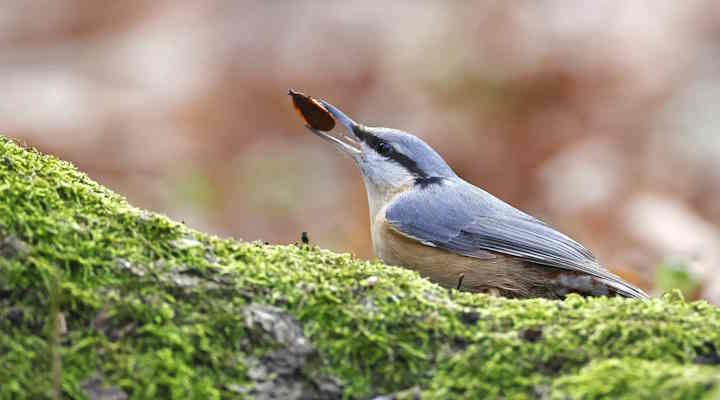
A Eurasian nuthatch with a beech nut
When foraging for beechnuts, it’s essential to do so sustainably. Ensuring the health of the forest ecosystem is vital. This means only gathering what you need and leaving enough for wildlife and other foragers. It’s also crucial to avoid damaging the trees or disturbing the surrounding habitat.
Additionally, knowing how to identify tree species and nuts correctly is essential. You must avoid accidentally harvesting an inedible plant species or damaging the environment.
Local laws and regulations are another consideration before foraging. In some areas, you may require a permit to forage for wild nuts, berries, and plants. Additionally, certain species may be protected, and it’s illegal to forge for them.
Beechnuts: FAQs
How can I tell if beechnut husks are empty?
Fungal diseases or wildlife can mean you come across many empty husks when foraging. Empty beech nut husks are typically lighter and feel hollow when squeezed. Look for a lack of resistance when pressing the husk, indicating that the nut inside has been consumed or fallen out.
Are there any risks associated with eating beech nuts?
Consuming large quantities of raw beech nuts is not recommended. The small creamy-white nuts contain a toxin called saponin glycosides, which can cause digestive discomfort. Therefore, roasting the nuts to eliminate the toxins is crucial when using beech nuts in culinary applications.
Additionally, you should exercise caution if you have nut allergies, as you are most likely allergic to beech nuts.
How can I tell if beech nuts are ripe and ready to eat?
In the fall, the spiky husks split open, revealing the triangular nuts are ready for harvesting. Ripe beech nuts are easily identified by their brown shells and smooth texture. Splitting the shells reveals a creamy-white, triangular nut. Choose nuts that have fallen naturally from the tree, ensuring they are mature and suitable for consumption.
How can I tell if beech nuts have gone rancid?
Rancid beech nuts exhibit a sour, unpleasant odor, and a bitter taste. If the nuts elicit a strong and off-putting smell or taste, they have likely gone rancid and should be discarded. Check for any signs of discoloration or a slimy texture, indicating spoilage. Fresh beech nuts have a mildly sweet and nutty aroma.
Related articles:
